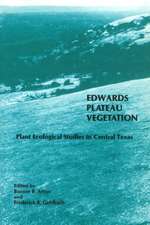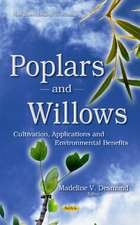Pseudomonas syringae and related pathogens: Biology and Genetic
Editat de Nicola Sante Iacobellis, Alan Collmer, Steven W. Hutcheson, John W. Mansfield, Cindy E. Morris, Jesús Murillo, Norman W. Schaad, David E. Stead, Giuseppe Surico, Matthias S. Ullrichen Limba Engleză Hardback – 31 dec 2003
| Toate formatele și edițiile | Preț | Express |
|---|---|---|
| Paperback (1) | 1071.97 lei 38-44 zile | |
| SPRINGER NETHERLANDS – 25 dec 2010 | 1071.97 lei 38-44 zile | |
| Hardback (1) | 1251.19 lei 6-8 săpt. | |
| SPRINGER NETHERLANDS – 31 dec 2003 | 1251.19 lei 6-8 săpt. |
Preț: 1251.19 lei
Preț vechi: 1525.84 lei
-18% Nou
Puncte Express: 1877
Preț estimativ în valută:
239.40€ • 249.99$ • 197.70£
239.40€ • 249.99$ • 197.70£
Carte tipărită la comandă
Livrare economică 15-29 aprilie
Preluare comenzi: 021 569.72.76
Specificații
ISBN-13: 9781402012273
ISBN-10: 1402012276
Pagini: 725
Ilustrații: XVII, 708 p.
Dimensiuni: 155 x 235 x 32 mm
Greutate: 1.41 kg
Ediția:2004
Editura: SPRINGER NETHERLANDS
Colecția Springer
Locul publicării:Dordrecht, Netherlands
ISBN-10: 1402012276
Pagini: 725
Ilustrații: XVII, 708 p.
Dimensiuni: 155 x 235 x 32 mm
Greutate: 1.41 kg
Ediția:2004
Editura: SPRINGER NETHERLANDS
Colecția Springer
Locul publicării:Dordrecht, Netherlands
Public țintă
ResearchCuprins
Epidemiological Clues for Developing Methods of Control of Bacterial Blight of Cantaloupe Caused by Pseudomonas syringae pv. aptata.- Olive Knot Disease: New Insights into the Ecology, Physiology and Epidemiology of Pseudomonas savastanoi pv. savastanoi.- Exploring Pseudomonas syringae Ecology via Direct Microscopic Observations of the Leaf Surface.- Stress Resistance in Pseudomonas syringae: Mechanisms and Strategies.- Diversity of Epiphytic Pseudomonads on Grass and other Plant Species.- Survival of Two Biocontrol Pseudomonas Strains in Tomato Fruits After Inoculations at Flowering Through Fruit Ripening.- Diversity among Pseudomonas syringae Strains from Belgian Orchards.- Epiphytic Fitness of Pseudomonas syringae pv. syringae on Mango Trees is Increased by 62-Kb Plasmids.- Evidence that Acidovorax valerianellae, Bacterial Black Spot of Corn Salad (Valerianella locusta) Agent, is Soil Transmitted.- Pseudomonas Leek Blight: Study of Seed Transmission.- Distribution and Virulence of Pseudomonas syringae pv. atrofaciens, Causal Agent of Basal Glume Rot, in Russia.- Survival of Biocontrol Pseudomonas Strains and Human Pathogens in Fruit Juices.- Antagonistic Activity of Pseudomonas syringae subsp. savastanoi: Preliminary Results on the Identification of a Plasmid-located Genetic Determinant.- Methods for the Identification of Virulence Genes in Pseudomonas syringae.- Characteristics of the syr-syp Genomic Island of Pseudomonas syringae pv. syringae Strain B301D.- Regulation and Detection of Effectors Translocated by Pseudomonas syringae.- Genetic Organisation and Proposed Function of the hrpM Locus of Pseudomonas syringae pv. syringae.- Is Pore Formation Activity of HrpZ Required for Defence Activation in Plant Cells?.- An Antimetabolite Toxin (Mangotoxin) is Produced byPseudomonas syringae pv. syringae Isolated from Mango.- Antimicrobial Lipodepsipeptides from Pseudomonas spp: a Comparison of Their Activity on Model Membranes.- Temperature-Regulated Biosynthesis of Coronatine by Pseudomonas syringae in vitro and in planta.- Interaction of Syringomycin E Structural Analogues with Biological and Model Membranes.- Substrate Specificity of Syringomycin Synthetase Adenylation Domains.- Identification of Virulence Factors from Pseudomonas syringae.- Toxic Metabolites and Lipopolysaccharides from Pseudomonas cichorii.- Chemical and Biological Characterisation of Tolaasins A–E: New Lipodepsipeptides Produced by Pseudomonas tolaasii.- Production of Tolaasin I and WLIP by Pseudomonas tolaasii and P. “reactans”, their Antimicrobial Activity and Possible Role in the Virulence of the Pathogens.- Interaction of Tolaasin I and WLIP, Lipodepsipeptides of Pseudomonas tolaasii and P. “reactans “, with Biological and Model Membranes.- In Pseudomonas syringae pv. phaseolicola the Synthesis of Phaseolotoxin and the Concurrent Expression of the argK Gene Coding for the Phaseolotoxin-Resistant Ornithyl-Carbamoyl Transferase Occur Independent of the Global Arginine Regulator ArgR.- The HRP Pilus of Pseudomonas syringae.- Pseudomonas syringae Pathogenesis in Arabidopsis.- Early Induced Resistance, a General, Symptomless Plant Response to Bacteria.- Role of Flagella and Flagellin in Plant — Pseudomonas syringae Interactions.- Preliminary Investigations on the Role of Nitric Oxide in Systemic Acquired Resistance in the Arabidopsis thaliana-Pseudomonas syringae Pathosystem.- Does the Harpin of Pseudomonas syringae Interact with a Host Protein?.- Lanthanum Inhibits Programmed Cell Death but not Resistance in the Tobacco — Pseudomonas savastanoi pv.phaseolicola Incompatible Interaction.- Pseudomonas in the Underworld: the Secret Life of Pseudomonas fluorescens SBW25.- Regulation of Coronatine Biosynthesis in Pseudomonas syringae.- Genomic Mining for Substrates of the Type III Secretion System of Pseudomonas syringae pv. tomato DC3000: New Insights into Mechanisms of Pathogenesis.- Contribution of Virulence Determinants from Pseudomonas and Other Bacteria to hrp-dependent Gall Formation by Erwinia herbicola pv. gypsophilae.- Strain-specific Sequence Alterations in the Gene Encoding the Histidine Protein Kinase CorS Might be Responsible for Temperature-dependent Production of the Phytotoxin Coronatine by Pseudomonas syringae.- Characterisation of Effector Genes of Pseudomonads Causing Disease on Hazelnut.- Generation of Microarrays for the Study of Gene Expression Patterns in Ralstonia solanacearum.- Sequence Analysis of the hrpC Operon and the hrpE gene of Pseudomonas syringae subsp. savastanoi.- Classification and Identification of Plant Pathogenic Pseudomonas species by REP-PCR Derived Genetic Fingerprints.- Control of Pseudomonas syringae Pathovars.- Enhancing the Efficacy of Bioherbicides.- Integrated Management of Bacterial Streak and Bulb Rot of Onion.- Control of Olive Knot Disease with a Bacteriocin.- Use of Oxos, a Complex of Hydrogen Peroxide, Acetic Acid and Silver Ion, to Control Bacterial Speck of Tomato (Pseudomonas syringae pv. tomato) and Angular Leaf Spot of Melon (P. s. pv. lachrymans).- Screening Wild Cherry Micropropagated Plantlets for Resistance to Bacterial Canker.- Investigations on the Systemic Acquired Resistance Induced by Acibenzolar-S-Methyl in Tomato Plants Against Pseudomonas syringae pv. tomato.- Integrated Management of Bacterial Decline of Hazelnut, by Using Bion as an Activator of Systemic Acquired Resistance (SAR).- Response of Some Olive Cultivars, Hybrid and Open Pollinated Seedlings to Pseudomonas savastanoi pv. savastanoi.- Preliminary Results on the Antibacterial Activity of Essential Oils on Some Pathovars of Pseudomonas syringae.- Pathovars of Pseudomonas syringae are Structured in Genetic Populations Allowing the Selection of Specific Markers for their Detection in Plant Samples.- Real — Time PCR for Ralstonia solanacearum.- Optimising PCR detection of Ralstonia solanacearum and Pseudomonas savastanoi pv. savastanoi: Two Models, Two Approaches.- Use of PCR for Rapid Identification of Acidovorax avenae and A. avenae subsp. citrulli.- Limitations of the Current Methods for the Detection of Spanish Strains of Pseudomonas syringae pv. phaseolicola.- Detection of Pseudomonas syringae pv. tomato by PCR.- Current Status of Some New and Some Old Plant Pathogenic Pseudomonads.- Emergence of Acidovorax avenae subsp. citrulli as a Crop Threatening Disease of Watermelon and Melon.- The Pseudomonads Associated with Bacterial Canker and Decline of Hazelnut (Corylus avellana L.).- Pseudomonas “reactans” a New Pathogen of Cultivated Mushrooms.- Identification of Pseudomonas Species from a Variety of Hosts in the Salinas Valley of California.- Bacterial Canker of Hazelnut (Corylus avellana L.) in Sardinia (Italy): Occurrence of Pseudomonas syringae Strains.- Pseudomonas huttiensis Associated with Leaf Necrosis and Blighting of Tomato Seedlings in the Greenhouse.- An Unusual Pseudomonad Isolated From Diseased Parsley Roots in Serbia.- Occurrence of Apical Shoot Chlorosis and Whitening of Pea Caused by Strains of Pseudomonas syringae pv. pisi.- Taxonomy of Pseudomonas syringae Pathovars: Classification and Nomenclature.- Phytopathogenic“Pseudomonas” Species: a Taxonomic Overview.- Characterisation of an Acidovorax sp. Associated with Geranium and Petunia.- Bacterial Canker of Wild Cherry Tree in France Caused by a new Pathovar of Pseudomonas syringae pv. avii (pv. nov. ).- Phenotypic Characteristics of Pseudomonas savastanoi Strains from Various Hosts.- Phylogenic Analysis of DNA Sequences Around the hrpL and hrpZ Regions of Pseudomonas syringae Group Bacteria.- Molecular Characterisation of Spanish Pseudomonas syringae pv. phaseolicola Isolates.- Author Index.













